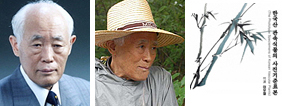- 글로벌메뉴
- KOREAN

 Korea Biodiversity Information System > Bioinformation Library > DataRoom > Taxonomy Data Room > Introduction to Jukpa Data
Korea Biodiversity Information System > Bioinformation Library > DataRoom > Taxonomy Data Room > Introduction to Jukpa Data

The “Prototype Specimens of Korean Vascular Plants” is a collection of 10,744 slides that I’ve collected from home and abroad. This includes image data on 8,865 slides selected from 61,588 plant specimens stored in the University of Tokyo, University of Kyoto, and National Science Museum in 1984-1985, and produced especially to write “Lineamenta Florae Korea,” and 1,879 slides additionally collected from domestic and foreign herbariums in 1995-1996. The only black and white slides are those from Kyoto University, and the rest are in full color. In order to compare variations of individual species, I’ve included specimens from Japan, Korea, Manchuria, China, and Taiwan. Also, for purposes of accuracy, I’ve tried to include specimens from Tokyo University’s T. Nakai, M. Honda, H. Hara, and T. Yanazaki, Kyoto University’s G. Koidzumi, the National Science Museum of Japan’s J. Ohwi, the Academy of Sciences of Manchuria’s M. Kitagawa, the University of Taiwan’s B. Hayata, and other well-known people active in Korea, such as T. Ishidoya, and H. Uyeki. For plants that were collected in Korea but not reported or identified yet, I used [Specimen + sp.] for future research purposes. I've had an interest in Leontopodium, Abelia, Violaceae and Liliaceae, and used all the specimens possessed by three herbariums in Japan.
There are 668 slides (seven slides for research) written with Holotype, Isotype, Paratype, Lectotype, Syntype, Isosyntype, Topotype, Co-type, etc., and 525 specimens were organized from this information to publish “Korean Plant Myeonggo.” These were recently reexamined to identify how they were organized and how their scientific names were given, and in 2010, the results were published as an e-book, “Type Specimens of Korean Vascular Plants,” with image data on type specimens, and distributed in a diskette free of charge.
I’ve used the term prototype specimen for convenience. Most type specimens cited for describing new specimens are kept at foreign herbariums because all the early research was done by foreign scholars. T. Nakai, the scholar of plant classification at the University of Tokyo, was appointed as a Korean plant research commissioner (1914-1942) and investigated native plants all over Korea with Taehyun Jeong (1882-1971) in the Korea Forest Service. Some of the specimens made by them were sent to and stored in the National Regional Experiment Station, but most of them were lost during the Korean War. Moreover, because of the division of territory, it is impossible to obtain North Korean plants at present.
The purpose for releasing this prototype specimen database through the Korea Biodiversity Information System and on diskettes is to make literature information and intellectual properties that I have collected and used during my life widely available for future generations. The first output to meet this purpose was the publication and distribution of “Original Descriptions of Korean Vascular Plants I” (2008) as an article that was not for sale, which identified the sources of my 5,111 original descriptions for Korean vascular plants, extracted from foreign documents, and I organized my opinions attached at the end of them. The second output was the distribution of diskettes containing “Type Specimens of Korean Vascular Plants” (2010), and the third output was the distribution of diskettes containing “The Prototype Specimens of Korean Vascular Plants” (2010).
In particular, “The Prototype Specimens of Korean Vascular Plants” corresponds to a revised version of my earlier work (“Lineamenta Florae Korea”), and “原色韓國基準植物圖鑑.” Unfortunately, I didn’t have enough time to proofread “Korean Plant Myeonggo,” so there are a lot of errors in it. And only 2,947 specimens were included in the illustrated book because I had to quickly make a revised edition of the “Korea Illustrated Plant Book” (Tae Hyun Jeong, 1956-1957) to raise money for Professor Jung’s Haeun Biology Award (霞隱生物學賞). Of course, these errors were corrected in the “Origin of Korean Plant Names” (2005), but I was not able to publish a revised edition of the book reflecting all the contents of the prototype specimens among the 4,011 taxa included in the “Myeonggo.” Thus, I intended to compensate for this by showing the slides cited in the above-mentioned books. It is considered that this publication will resolve some problems where many photos of foreign specimens were used because they were selected for their clarity and character state, and it was difficult to identify the characteristics of each taxon because the photos were too small.
Although I tried my best when I made “The Prototype Specimens of Korean Vascular Plants,” I realize that there will be minor mistakes in these slides. Thus, I expect to complement additional image data for some taxa without type specimens, as well as accumulating more-exact data through reviews of this data by specialized experts. In addition, I also expect that Korean plant lovers can use them to identify plants exactly.
Anybody can use this source for free, because it is not for sale. However, make sure to specify the source of the data if you wish to use it for other purposes.
Finally, I would like to sincerely thank President Ko Shung-Chul, Professor Oh Byung-Woon and the Korea National Arboretum for sharing this resource with many younger students.
At Jukpa resting place on 2012 August,
Lee Wu-Chul